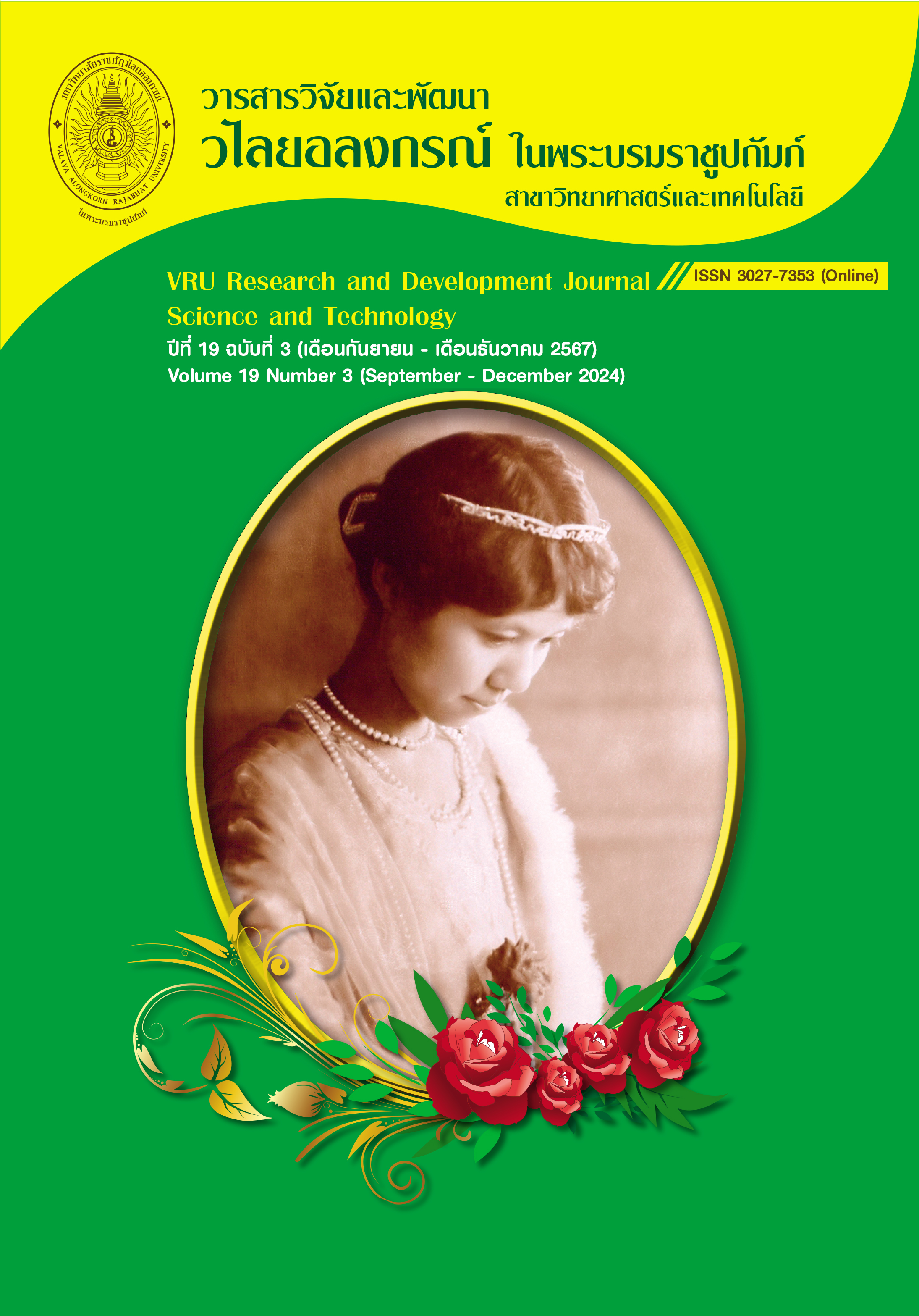IMPROVING THE RULE CURVE OF A RESERVOIR SYSTEM USING TABU SEARCH AND WIND-DRIVEN OPTIMIZATION TECHNIQUES
Main Article Content
Abstract
This research aimed to apply an optimal search technique together with a reservoir system simulation model to find the appropriate rule curve for the reservoir. The objective function of the search was to calculate the average of the least water shortage and the average of the least water surplus. This research used water data from 1994 to 2022, totaling 28 years, from Oon Reservoir in Rae Subdistrict, Phang Khon District, Sakon Nakhon Province. These data included the amount of water flowing each month, information on water demand from reservoirs, and hydrological and physical data of the reservoir. Additionally, 1,000 water inflow events into the reservoir were simulated to evaluate the performance of the rule curve generated from the model. The results were presented in the form of situations of water scarcity and water surplus which specified the period of the event, average water volume, and maximum water volume. The research results indicate that the rule curves derived from various models exhibit similar trends due to seasonal water variations and similar conditions. When tested and compared to the current rule curve, the Wind-Driven Optimization (WDO)technique demonstrated superior capability in reducing the severity of water surplus situations compared to the Tabu Search Algorithm (TSA) and the current rule curve. Nevertheless, both models outperformed the current rule curve.
Downloads
Article Details
ลิขสิทธิ์บทความวิจัยที่ได้รับการตีพิมพ์เผยแพร่ในวารสารวิจัยและพัฒนา วไลยอลงกรณ์ ในพระบรมราชูปถัมภ์ ถือเป็นกรรมสิทธิ์ของสถาบันวิจัยและพัฒนา มหาวิทยาลัยราชภัฏวไลยอลงกรณ์ ในพระบรมราชูปถัมภ์ ห้ามนำข้อความทั้งหมดหรือบางส่วนไปพิมพ์ซ้ำ เว้นแต่จะได้รับอนุญาตจากมหาวิทยาลัยเป็นลายลักษณ์อักษร
ความรับผิดชอบ เนื้อหาต้นฉบับที่ปรากฏในวารสารวิจัยและพัฒนา วไลยอลงกรณ์ ในพระบรมราชูปถัมภ์ เป็นความรับผิดชอบของผู้นิพนธ์บทความหรือผู้เขียนเอง ทั้งนี้ไม่รวมความผิดพลาดอันเกิดจากเทคนิคการพิมพ์
References
เจษฎา ตงศิริ, และอนงค์ฤทธิ์ แข็งแรง. (2561). การพยากรณ์ปริมาณนํ้าท่าในอนาคตภายใต้การเปลี่ยนแปลงลักษณะทางอุทกวิทยาและการปรับปรุงโค้งควบคุมอ่างเก็บนํ้า นํ้าอูน ด้วยเทคนิคเจเนติกอัลกอริทึม. Journal of Science & Technology MSU, 37(6).
ณัฐพล แก้วทอง, ปกรณ์ ดิษฐกิจ, สรายุทธ์ นาครอด, และชยณัฐ บัวทองเกื้อ. (2563). การประยุกต์ใช้แบบจำลองคณิตศาสตร์ HEC-HMS และ HEC-RAS เพื่อศึกษาแนวทางการบรรเทาอุทกภัยของอำเภอชะอวด จังหวัดนครศรีธรรมราช. Journal of Science & Technology MSU, 39(3).
วิเชียร ปลื้มกมล. (2536). การสังเคราะห์ข้อมูลน้ำท่าโดยใช้โปรแกรม HEC-4 (Runoff Generation by HEC-4). Engineering and Applied Science Research, 20(1), 31-37.
Bhumiphan, N. (2021). Improvement of Optimal Reservoir Operation Rule Curve by Tabu Search: A Case Study of Huai Luang. วารสารวิชาการพระจอมเกล้าพระนครเหนือ, 31(3), 461-470.
Gilmore, P. C., & Gomory, R. E. (1963). A linear programming approach to the cutting stock problem—Part II. Operations research, 11(6), 863-888.
Hormwichian, R., Kangrang, A., Lamom, A., Chaleeraktrakoon, C., & Patamatamkul, S. (2012). Coupled-operations model and a conditional differential evolution algorithm for improving reservoir management. International Journal of Physical Sciences, 7(42), 5701-5710.
Ibrahim, I. A., Hossain, M., Duck, B. C., & Nadarajah, M. (2020). An improved wind driven optimization algorithm for parameters identification of a triple-diode photovoltaic cell model. Energy Conversion and Management, 213, 112872.
Kosasaeng, S., Yamoat, N., Ashrafi, S. M., & Kangrang, A. (2022). Extracting Optimal Operation Rule Curves of Multi-Reservoir System Using Atom Search Optimization, Genetic Programming and Wind Driven Optimization. Sustainability, 14(23), 16205.
Kumar, D. N., & Baliarsingh, F. (2003). Folded dynamic programming for optimal operation of multireservoir system. Water Resources Management, 17, 337-353.
Kundu, S., Khare, D., & Mondal, A. (2017a). Individual and combined impacts of future climate and land use changes on the water balance. Ecological Engineering, 105, 42-57.
Kundu, S., Khare, D., & Mondal, A. (2017b). Past, present and future land use changes and their impact on water balance. Journal of environmental management, 197,
-596.
Mendoza, R. R., Arganis J. M. L., Domínguez M. R., Padilla M. L. D., Fuentes M. Ó. A., Mendoza Reséndiz, A., Carrizosa E. E., & Carmona P. R. B. (2021). Operation policies through dynamic programming and genetic algorithms, for a reservoir with irrigation and water supply uses. Water Resources Management, 35, 1573-1586.
Nagesh K. D., Baliarsingh, F., & Srinivasa R. K. (2010). Optimal reservoir operation for flood control using folded dynamic programming. Water Resources Management, 24, 1045-1064.
Ngamsert, R., & Kangrang, A. (2019). Estimation of Water Demand from Reservoirby Participation and Reservoir Operation. (Doctoral dissertation, Mahasarakham University).
Peng, Y., Peng, A., Zhang, X., Zhou, H., Zhang, L., Wang, W., & Zhang, Z. (2017). Multi-Core parallel particle swarm optimization for the operation of Inter-Basin water transfer-supply systems. Water Resources Management, 31, 27-41.
Rodriguez, L. B., Cello, P. A., Vionnet, C. A., & Goodrich, D. (2008). Fully conservative coupling of HEC-RAS with MODFLOW to simulate stream–aquifer interactions in a drainage basin. Journal of Hydrology, 353(1-2), 129-142.
Spiliotis, M., Mediero, L., & Garrote, L. (2016). Optimization of hedging rules for reservoir operation during droughts based on particle swarm optimization. Water Resources Management, 30, 5759-5778.
Techarungruengsakul, R., & Kangrang, A. (2019). Estimation of Reservoir Inflow by Participation and Reservoir Operation. (Doctoral dissertation, Mahasarakham University).

